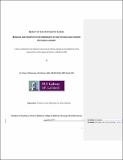| dc.contributor.advisor | McDonald, Colm | |
| dc.contributor.advisor | Hallahan, Brian | |
| dc.contributor.author | McInerney, Shane | |
| dc.date.accessioned | 2017-10-10T12:16:19Z | |
| dc.date.available | 2017-10-10T12:16:19Z | |
| dc.date.issued | 2017-08-01 | |
| dc.identifier.uri | http://hdl.handle.net/10379/6901 | |
| dc.description.abstract | Abstract
The overall aim of this thesis was to longitudinally assess determinants of quality of life in first episode and chronic psychosis patient cohorts.
The Galway First Episode Psychosis Cohort
Background:
In this study, first episode psychosis (FEP) patients were followed up after a minimum of three years in order to determine the extent to which clinical and morphometric indices were associated with quality of life (QoL).
Method:
45 patients were recruited into the study and a proportion of these (n=32) underwent clinical and neuroimaging investigations at both baseline and follow up.
Results:
Lower QoL was predicted clinically by higher baseline negative symptoms and improvement in negative symptoms predicted higher QoL 3 years later. From a neuroimaging perspective, left lateral ventricular volume enlargement over the follow up period was associated with lower QoL.
Conclusions:
This study demonstrated that it was the trajectory of clinical and morphometric measures over time, particularly with respect to negative symptoms and left lateral ventricular volume, that are most associated with QoL as an outcome measure. Such measures may represent markers of a neuroprogressive process that ultimately determines the functional outcome after the onset of psychotic illness.
QoL of long-stay psychiatric patients transferred into the community
Background: This study comprised a cohort of former long-stay institutionalised patients who were subsequently transferred into local community settings.
Method: 87 former long-stay psychiatric patients, the majority of whom had a diagnosis of schizophrenia, were assessed at baseline (one month prior to hospital closure) and 10 years later on a range of QoL and functional measures. The QoL measure (Quality of Life Scale) was only conducted at the follow up period.
Results: Improvements were noted for both QoL and social functioning at 10 year follow up. Linear regression analysis found that baseline social behaviour predicted QoL at follow up.
Conclusion: This study demonstrates that transfer into the community from a psychiatric institution is associated with long-term improvement in QoL and social functioning, even in individuals who have spent large periods of time in such environments. Those patients who demonstrated the greatest improvement in QoL had higher baseline social skills. | en_IE |
| dc.rights | Attribution-NonCommercial-NoDerivs 3.0 Ireland | |
| dc.rights.uri | https://creativecommons.org/licenses/by-nc-nd/3.0/ie/ | |
| dc.subject | Psychiatry | en_IE |
| dc.subject | Medicine | en_IE |
| dc.subject | Psychosis | en_IE |
| dc.subject | Quality of life | en_IE |
| dc.title | Quality of life in psychotic illness: baseline and prospective determinants in first episode and chronic psychosis cohorts | en_IE |
| dc.type | Thesis | en_IE |
| dc.local.note | This thesis assessed quality of life (QoL) of first episode psychosis and chronic psychosis over time. In the FEP study, clinical and brain imaging changes were associated with QoL after three years. The second study of chronic patients found improvements in QoL and social functioning at 10 year follow up. | en_IE |
| dc.local.final | Yes | en_IE |
| nui.item.downloads | 861 | |


